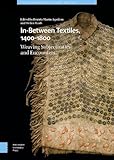In-Between Textiles, 1400-1800 : Weaving Subjectivities and Encounters / ed. by Stefan Hanß, Beatriz Marín-Aguilera.
Material type: TextSeries: Visual and Material Culture, 1300 –1700 ; 44Publisher: Amsterdam : Amsterdam University Press, [2023]Copyright date: ©2023Description: 1 online resource (388 p.)Content type:
TextSeries: Visual and Material Culture, 1300 –1700 ; 44Publisher: Amsterdam : Amsterdam University Press, [2023]Copyright date: ©2023Description: 1 online resource (388 p.)Content type: - 9789048556960
- 746.09/024 23/eng/20230227
- NK8806 .I53 2023eb
- online - DeGruyter
| Item type | Current library | Call number | URL | Status | Notes | Barcode | |
|---|---|---|---|---|---|---|---|
 eBook
eBook
|
Biblioteca "Angelicum" Pont. Univ. S.Tommaso d'Aquino Nuvola online | online - DeGruyter (Browse shelf(Opens below)) | Online access | Not for loan (Accesso limitato) | Accesso per gli utenti autorizzati / Access for authorized users | (dgr)9789048556960 |
Frontmatter -- Visual and Material Culture, 1300-1700 -- Table of Contents -- List of Illustrations -- Acknowledgements -- 1. Subjectivities In-Between Early Modern Global Textiles -- Part I Unhomeliness, Mimicry, and Mockery -- 2. Māori Textiles and Culture -- 3. Contesting Images -- 4. “A Few Shreds of Rough Linen” and “a Certain Degree of Elegance” -- Part II The Material Enunciation of Difference -- 5. Textiles, Fashion, and Questions of Whiteness -- 6. Abolitionism and Kente Cloth -- 7. Dressing in the Deccan -- 8. “Rags of Popery” -- Part III Identity Effects In-Between the Local and the Global -- 9. Globalising Iberian Moorishness -- 10. Tornasol Techniques as Cultural Memory -- 11. In-Between the Global and the Local -- 12. African Cotton : Cultural and Economic Resistance in Mozambique in the Mid-Eighteenth Century -- Part IV Material Translation and Cultural Appropriation -- 13. Mediating Mediterranean Cultures -- 14. The Material Translation of Persian and Indian Carpets and Textiles in Early Modern Japan -- 15. Globalisation and the Manufacture of Tablet-Woven Sanctuary Curtains in Ethiopia in the Eighteenth Century -- 16. Cochineal and the Changing Patterns of Consumption of Red Dyes in Early Modern European Textile Industries -- Archives, Libraries, and Museums (Abbreviations) -- Select Bibliography -- Index
restricted access online access with authorization star
http://purl.org/coar/access_right/c_16ec
In-Between Textiles is a decentred study of how textiles shaped, disrupted, and transformed subjectivities in the age of the first globalisation. The volume presents a radically cross-disciplinary approach that brings together world-leading anthropologists, archaeologists, art historians, conservators, curators, historians, scientists, and weavers to reflect on the power of textiles to reshape increasingly contested identities on a global scale between 1400 and 1800. Contributors posit the concept of “in-between textiles,” building upon Homi Bhabha’s notion of in-betweenness as the actual material ground of the negotiation of cultural practices and meanings; a site identified as the battleground over strategies of selfhood and the production of identity signs troubled by colonialism and consumerism across the world. In-Between Textiles establishes cutting-edge conversations between textile studies, critical cultural theory, and material culture studies to examine how textiles created and challenged experiences of subjectivity, relatedness, and dis/location that transformed social fabrics around the globe.
Mode of access: Internet via World Wide Web.
In English.
Description based on online resource; title from PDF title page (publisher's Web site, viewed 06. Mrz 2024)


